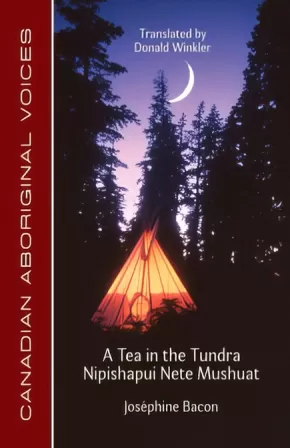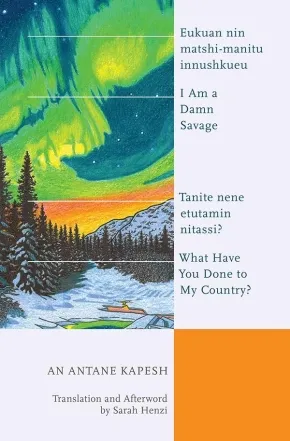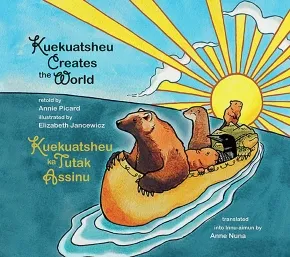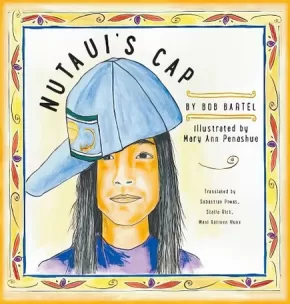
Innu-aimun
Books (2)
A Tea in the Tundra / Nipishapui Nete Mushuat
$16.95
Format:
Paperback
Text Content Territories:
Indigenous Canadian; First Nations; Innu (Montagnais-Naskapi);
Grade Levels: 12; University/College;
ISBN / Barcode: 9781772310351
Synopsis:
Synopsis:
In this bilingual English-Innu poetry collection, Joséphine Bacon challenges our traditional notions of culture and perception, landscape and wilderness, the limits of experience, and the nature of human being. With a surreal blend of emotions and memories, A Tea in the Tundra / Nipishapui Nete Mushuat portrays a complex and ever-shifting landscape of possibilities. The author passionately reveals a finely wrought sensibility, which elevates the subtle scenery of life's everyday events.
Educator & Series Information
This book is part of the Canadian Aboriginal Voices series.
Additional Information
96 pages | 5.50" x 8.50" | Translated by Donald Winkler
I Am a Damn Savage; What Have You Done to My Country?
$22.99
Format:
Paperback
Text Content Territories:
Indigenous Canadian; First Nations; Innu (Montagnais-Naskapi);
Grade Levels: University/College;
ISBN / Barcode: 9781771124089
Synopsis:
Synopsis:
Quebec author An Antane Kapesh's two books, Je suis une maudite sauvagesse (1976) and Qu'as-tu fait de mon pays? (1979), are among the foregrounding works by Indigenous women in Canada. This English translation of these works, presented alongside the revised Innu text, makes them available for the first time to a broader readership.
In I Am a Damn Savage, Antane Kapesh wrote to preserve and share her culture, experience, and knowledge, all of which, she felt, were disappearing at an alarming rate because many Elders – like herself – were aged or dying. She wanted to publicly denounce the conditions in which she and the Innu were made to live, and to address the changes she was witnessing due to land dispossession and loss of hunting territory, police brutality, and the effects of the residential school system. What Have You Done to My Country? is a fictional account by a young boy of the arrival of les Polichinelles and their subsequent assault on the land and on native language and culture.
Through these stories Antane Kapesh asserts that settler society will eventually have to take responsibility and recognize its faults, and accept that the Innu – as well as all the other nations – are not going anywhere, that they are not a problem settlers can make disappear.
Additional Information
216 pages | 5.25" x 8.00" | Translation and Afterword by Sarah Henzi
Kids Books (2)
Kuekuatsheu Creates the World / Kuekuatsheu ka Tutak Assinu: (Sheshatshiu dialect)
$24.99
Artists:
Format:
Hardcover
ISBN / Barcode: 9781998802203
Synopsis:
Synopsis:
The story of how the world came to be on the turtle's back can be found in Indigenous cultures throughout North America/Turtle Island. It has many variations. This moving version of the tale—a story of resilience, sacrifice, and friendship—is one that Annie Picard was often told as a child by her maternal grandmother while they lived in nutshimit (on the land) in the Labrador/Quebec peninsula. Picard's lovely re-telling of this traditional Innu story of how little muskrat makes an enormous sacrifice to help the wolverine and his other friends rebuild the world after a great flood is brought vividly to life by Elizabeth Jancewicz's stunning illustrations.
Educator Information
Recommended for ages 4 to 8.
Bilingual: English and Innu-aimun.
Translation into Innu-aimun by Anne Nuna.
Additional Information
36 Pages | 9" x 8" | Hardcover | 2nd Edition
Nutaui's Cap
$22.95
Artists:
Format:
Hardcover
Text Content Territories:
Indigenous Canadian; First Nations; Innu (Montagnais-Naskapi); Sheshatshiu Innu;
ISBN / Barcode: 9781927917244
Synopsis:
Synopsis:
Without warning, a deafening boom drove us to the ground, even Nutaui. I heard my heart pound hard against my chest. Seconds later another earsplitting blast struck us.
A moving story of protest and determination, Nutaui's Cap tells of a young Innu girl, Nanas. The low-level flying of NATO supersonic jets disrupts her family's traditional way of life, and endangers both them and the wildlife they depend upon, so Nanas' father and the other members of the Sheshatshiu community decide to protest by occupying the military's runways. Nanas is proud and eager to join in the social action, but then her father is arrested. Nanas has little to comfort her except his well-worn ball cap, and the promise of the land itself that the resilience, wisdom, and strength of the Innu people will one day triumph.
This true account of one small moment in the years-long struggle of the Innu people against NATO and the Canadian government brings to light the on-going fight for Innu rights on their own unceded land. Author Bob Bartel, an activist and volunteer, participated in the efforts to stop those NATO practice flights; he learned Nanas's story from her aunt and has Nanas's permission to tell the story. Bartel writes with care, simplicity, and deep awareness; he portrays with both power and subtlety the struggle as seen from a child's perspective.
Illustrations by acclaimed Innu artist Mary Ann Penashue capture the gentle relationship between Nanas and her father, and highlight the beauty and dignity of her people's culture. Her blending of traditional imagery with modern technique offers a visually rich and compelling accompaniment to Bartel's text.
Educator Information
Compelling story about Innu protests as seen from the perspective of child.
Author Bob Bartel, an activist and volunteer, participated in the efforts to stop those NATO practice flights; he learned Nanas's story from her aunt and has Nanas's permission to tell the story.
Nutaui's Cap has been translated into two dialects of Innu-aimun, both of which appear alongside the English. Some Innu-aimun words are also integrated into the English text; a glossary is provided. A map of the locations and a historical afterword, offering further context, are included as well.
Translated by Stella Rich, Sebastian Piwas, and Mani Katinen Nuna, with Laurel Anne Hasler, Penash Rich, and Marguerite MacKenzie
This book is a co-publication with Mamu Tshishkutamashutau Innu Education.
Recommended for ages 6 to 12.
Additional Information
68 pages | 9.00" x 9.00"










